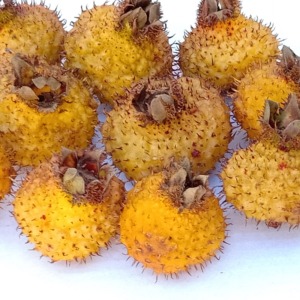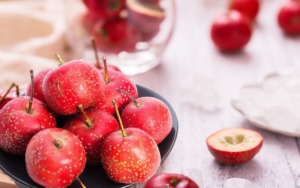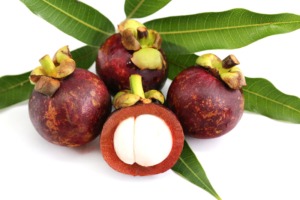-
Cili
Cili (Rosa roxburghii Tratt) is a kind of specific wild plant in Southwest China. Cili consists of several important components such as superoxide dismutase (SOD), polysaccharide, vitamin C, vitamin E, and some mineral elements (Zn and Ca). Additionally, SOD has long been regarded as a free radical scavenger and ascorbate, which is a highly potent aqueous‐phase antioxidant in plasma.
Cili has a number of beneficial effects on atherosclerosis, cancer, aging, and immunity stress. A set of indices, such as the activity of natural killer (NK) cells, free radical metabolism, microcirculation parameters, cognitive function, light reaction time, and cardiovascular function were selected to evaluate the effects of Cili among 50–75 years old people.
It demonstrated that Cili was able to enhance natural killer cell activity and strengthen immune function. Furthermore, the supplementation of Cili would significantly improve the antioxidative capacity and then reduce the injury effect on the endothelium of capillary, artery, and brain with the mechanism probably due to its bioactive components such as SOD, polysaccharides, vitamin C, vitamin E, etc.
Scientists found that Cili juice not only remarkably reduced low‐density lipoprotein (LDL) oxidative susceptibility but also suppressed oxidized Ox‐LDL‐induced macrophage growth and particularly Ox‐LDL‐induced cholesteryl ester (CE) accumulation in murine peritoneal macrophages by promoting cellular cholesterol efflux. These results indicated that the Cili juice exerted its antiatherogenic effects largely due to its ability to inhibit the oxidative modification of LDL and suppress the formation of foam cells.
Furthermore, the flavonoids of Cili exhibit radioprotection and anti‐apoptosis properties via the Bcl‐2(Ca2+)/Caspase‐3/ PARP‐1 pathway in mouse thymus. In addition, water‐soluble polysaccharide (RTFP) from Cili has shown the potential to be a functional ingredient or hypoglycemic agent in food, pharmaceutical, and cosmetic preparations. The digestion properties of a novel polysaccharide from Cili (RTFP‐3) under saliva simulated gastric, and small intestinal conditions were studied. Cili was proven to be a functional ingredient to improve human health and prevent diseases through regulating gut flora.
-
Goji
Goji (Lycium barbarum L.) berry has been used for centuries in traditional medicine practice in China. It contains mainly polysaccharides, polyphenols, and carotenoids with an ability to exert beneficial effects for the prevention of chronic diseases (cancer, atherosclerosis, obesity, and diabetes), and to promote weight loss and longevity. Also, there were results that showed that goji berry demonstrated significant reductions in feelings of tiredness after exercise. This indicates that goji berry may attenuate stress‐related reactivity and facilitate adaptation to physical stress during exercise. The content of polysaccharides in goji berry is more than 40%. Polysaccharides extracted from goji berry were reported to be effective in various potential health benefits. Goji polysaccharides were able to protect the seminiferous epithelium from structural damage and apoptosis, in testicular tissue culture and inhibit lipid peroxidation and cytochrome C suggesting an anti‐inflammatory effect.
These results showed that polysaccharides, might have visual skin‐protective properties. After investigating the therapeutic function of this fruit against neurodegeneration in the retina. It was found that goji extract could benefit neural tissue by inhibiting the loss of retinal ganglion cells in glaucoma. Goji polysaccharides were efficient antioxidants that can protect rat liver mitochondria from irradiation‐induced lipid peroxidation and protein oxidation by augmenting endogenetic antioxidant enzymes. Goji could elicit phenotypic and functional maturation of murine bone marrow‐derived dendritic cells might result in increasing the antitumor effects of dendritic cell‐based vaccine therapy. Meanwhile, the treatment with goji polysaccharides significantly raised antioxidant enzymes activity and inhibited malondialdehyde formation in heart, brain, and serum.
In addition, goji extract contained a great amount of flavonoids, including 247 μg myricetin, 296 μg quercetin, and 135 μg kaempferol. The extract showed a significant antioxidation activity as well.
-
Hawthorn
Hawthorn (Crataegus pinnatifida) has been used for many years for the treatment of various diseases in China. Chinese hawthorn has been widely used in the treatment of hyperlipidemia and cardiovascular diseases. In folk medicine, hawthorn has been used to treat asthma, hyperlipidemia.
Hawthorn leaves, fruits, and seeds have various active substances such as, flavonoids, triterpenic acids, and sesquiterpenes, which could be beneficial for humans. Many studies have shown that hawthorn can have beneficial effects on controlling and treating cardiovascular diseases, high blood sugar, dyslipidemia, obesity, and atherosclerosis. Flavonoids extracted in the leaves of hawthorn can significantly reduce atherosclerotic lesion areas, the fruit extracts contain two triterpenic acids (oleanolic acid and ursolic acid), which have the ability to inhibit the acyl‐coA‐cholesterol acyltransferase enzyme and reduce very low‐density lipoprotein (VLDL) and LDL cholesterol levels.
Also, a sesquiterpene found in the seeds of hawthorn, which exhibits the ability to inhibit platelet aggregation, thus showing antithrombotic activity. In addition, a series of metabolic syndrome effects of hawthorn, such as anti‐diabetic and anti‐obesity by lower plasma glucose and decrease in the rate of gluconeogenesis, anti–hyperlipidemia, and reduced atherosclerosis (in vivo and in vitro studies) were found.
Hawthorn has a high pectin content compared with other fruits. The hawthorn pectin content in fresh fruit is as high as 6.4% and the pectin oligosaccharides from hawthorn showed potential antiglycation activities. Moreover, in vitro antioxidant activity assays indicated that ultrasonic treatment significantly improved the antioxidant activity of pectin ultrasonic treatment and is an effective way to enhance the antioxidant activity.
-
Mangosteen
Mangosteen has been used as a traditional medicine for the treatment of diarrhea, inflammation, ulcer, skin infection, abdominal pain, astringent, dysentery, leucorrhoea, and gonorrhea for many years. The pericarp of mangosteen contains mangostin, tannin, xanthone, chrysanthemin, garcinone, gartanin, vitamin B1, B2, C, and other bioactive substances.
In addition, the pericarp of mangosteen showed potential as antioxidant ingredients in cosmetic formulations. Xanthones were considered to be really important for chemopreventive or therapeutic functions. Several studies represented that xanthone derivatives, as the major secondary metabolites of mangosteen, demonstrated antibacterial, antifungal, antioxidant, anticancer, antiplasmodial, and cytotoxic activities. So far, there are more than 68 xanthones isolated from the mangosteen fruit with the majority of them being α‐ and γ‐mangostin.
α‐mangostin, one of the important xanthone derivatives, could inhibit alveolar duct formation in a mouse mammary organ culture model and alleviate the carcinogen‐induced formation of aberrant crypt foci in a short‐term colon carcinogenesis model. a great cytotoxic activity of several xanthones were found against human leukemia HL60 cells, where α‐mangostin presented the most dramatic activity and induced apoptosis in human leukemia cell lines HL60, K562, NB4, and U937.
α‐mangostin‐induced apoptosis through the mitochondrial is associated with the inhibition of the Ca2+ ATPase pathway in pheochromocytoma PC12 cells. γ‐mangostin is a tetraoxygenated diprenylated xanthone derivative. It has been found that γ‐mangostin was able to bind to cyclooxygenase and inhibit its activity resulting in reduced production of prostaglandin E2 (PGE2), which would affect the activities of some cell types, such as neurons, glial, and endothelial cells at a high level.
The function of γ‐mangostin is supposed to contribute to its anti‐inflammatory activity due to the antiproliferative, apoptotic, and antioxidative properties of mangosteen extract. The results implied that the extract decreased the intracellular ROS production on SKBR3 human breast cancer cell lines significantly. The components in mangosteen probably serve as the potent anticancer agents and free radical scavengers.
-
Pomegranate
Pomegranate (Punica granatum) has been used as a traditional medicine in China to treat different ailments. Many epidemiological studies of the potential effects of pomegranate on cancer prevention, such as lung cancer, skin cancer, prostate cancer, breast cancer, etc. suggested that pomegranate could serve as a possible chemopreventive and therapeutic agent against different cancers.
Pomegranate juice has strong antioxidant and anti‐atherosclerotic functions due to its high portion of polyphenols such as ellagic acid (EA) in its free and bound forms (ellagitannins and EA glycosides), gallotannins, anthocyanins (cyaniding, delphinidin, and pelargonidin glycosides), and flavonoids (quercetin, kaempferol, and luteolin glycosides). Punicalagin, ellagic acid, and total pomegranate tannin could reduce the cell number of human oral, prostate, and colon tumor cells.
Furthermore, when concentrations of those compounds rose up to an equivalent level (w/w) with pomegranate juice, they were able to induce apoptosis in HT‐29 cells. Punicalagin is supposed to be the most potent antioxidant ingredient for its antioxidant properties. The radical scavenging ability of punicalagin was because of polyphenolic hydroxyl groups that enhance the antioxidative activity through additional resonance stability and o‐quinone or p‐quinone formation.
In addition, pomegranate juice consumption resulted in antiatherogenic influence with a remarkable reduction in oxidative stress in serum and monocytes‐macrophages, and macrophage uptake of oxidized LDL and then cellular cholesterol biosynthesis.
Some studies showed that both pomegranate flower and juice might prevent diabetic sequelae via peroxisome proliferator‐activated receptor‐γ binding and nitric oxide production. Antidiabetic compounds included oleanolic, ursolic, and gallic acids.
Pomegranate juice was also reported to decrease the potent downregulation of NOSⅢ induced by the oxidation of LDL in human coronary endothelial cells.
However, the total content of anthocyanins in pomegranate juice was reported to be higher than any other fruit juice tested for antioxidant activity. Pomegranate juice increased the biological actions of NO by protecting NO against oxidative destruction but reversed proatherogenic effects induced by perturbed shear stress.
Pomegranate seed oil is rich in Punicic acid, which could inhibit azoxymethane‐induced colon carcinogenesis, while the oil promoted Ig production by mouse splenocytes.
-
Seabuckthorn
Sea buckthorn consists of series of chemical compounds including vitamins, carotenoids, flavonoids, etc. It is found that the juice is rich in vitamin E, vitamin C, and flavonoids that are 13.3, 1,540, and 1,182 mg/L, respectively. More than 75% of the total vitamin E is in the form of α‐tocopherol, and isorhamnetin is one of the most active flavonol aglycones in sea buckthorn juice.
It was found that the juices, jams, and oils derived from seabuckthorn fruit and seeds have a wide range of beneficial anti‐inflammatory, anticancer, antioxidant, and anti‐atherosclerotic effects. These were attributed to the presence of phenolics, vitamins, minerals, amino acids, fatty acids, and phytosterols.
The supplementation of sea buckthorn juice showed a moderate decrease in the susceptibility of LDL to oxidation. The antioxidant activity of leaf extract of sea buckthorn was also detected. They revealed that the ethanolic leaf extract at a concentration of 100 and 250 mg/kg body weight significantly reduced the chromium‐induced oxidative damage. Meanwhile, sea buckthorn seed extract exhibited high antibacterial and antioxidant capacity, which is supposed to be due to its high phenolic contents. Sea buckthorn oil has high concentrations of lipophilic constituents, predominantly unsaturated fatty acids in triglyceride form, and phytosterols and vitamins A and E have a positive influence on human health, especially on the cardiovascular system.

Leave A Comment